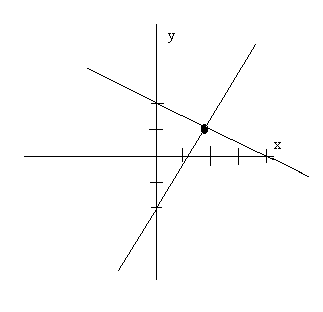Gaussian elimination
Gaussian elimination is a method for solving linear systems. The basic idea is to
transform a square system into an upper triangular system of equations which is easier to
solve. This is accomplished using three elementary row operations which change the form of
a linear system without changing the solution . In order of potential usefulness they are
- Elimination - subtract a multiple of one equation from another equation.
- Permutation - Interchange two rows.
- Scaling - Multiply an equation by a nonzero number.
Permutation does not change the solution of a linear system since it does not matter what order
the equations are written in. Scaling does not change the solution of a linear system since
multiplying an equation by a nonzero number does not change the solution. To see why elimination
preserves the solution consider the linear system below with solution (2,1)
æ x + 2y = 4 ö
è 3x - 2y = 4 ø
|
with graph

Subtracting 3 times row 1 from row 2 to yields
æ x + 2y = 4 ö
è -8y = -8 ø
|
with graph

Comparing the graphs we note that the lines have been rotated without changing the point of intersection.
Example: Solve
æ 2x + y + z = 180 ö
ç x + 3y + 2z = 300 ÷
è 2x + y + 2z = 240 ø
|
é 2 1 1 | 180 ù
ê 1 3 2 | 300 ú
ë 2 1 2 | 240 û
|
R1 < > R2
|
The pivot element is the first nonzero entry in the row
which does the elimination. The pivots are usually found
along the diagonal. When doing the arithmetic without a
computer we can often avoid fractions by making sure the
pivot element is 1. In this problem we can accomplish
this by exchanging rows 1 and 2. This is an optional step.
é 1 3 2 | 300 ù
ê 2 1 1 | 180 ú
ë 2 1 2 | 240 û
|
R2 > R2 - 2 R1
R3 > R3 - 2 R1
|
The goal of the gaussian elimination process is to zero
out the entries below the diagonal using the elimination
step. The elimination step involves replacing a row with
itself minus a multiple of another row. The multiple is
computed using
entry to eliminate
multiplier = .
pivot
|
We now proceed to zero out the entries below the first
diagonal entry. The required multipliers are 2/1 = 2
and 2/1 = 2. The calculations leading to a new row 2 are
2-2(1) = 0, 1-2(3) = -5, 1-2(2) = -3, 180-2(300) = -420.
The calculations leading to a new row 3 are
2-2(1) = 0, 1-2(3) = -5, 2-2(2) = -2, 240-2(300) = -360.
Notice that each time you zero out an element you must
change an entire row.
é 1 3 2 | 300 ù
ê 0 -5 -3 |-420 ú
ë 0 -5 -2 |-360 û
|
R3 > R3 - R2
|
We now zero out the entry below the second diagonal
element. The required multiplier is -5/-5 = 1 and the
calculations leading to a new row 3 are
0-1(0) = 0, -5 -1(-5) = 0, -2-1(-3) = 1, -360-1(-420) = 60.
é 1 3 2 | 300 ù æ x + 3y + 2z = 180 ö
ê 0 -5 -3 |-420 ú OR ç -5y - 3z = -420 ÷
ë 0 0 1 | 60 û è z = 60 ø
|
The system of linear equations above is equivalent to
the original system but it is much easier to solve.
The third equation has only the variable z and it is
easy to solve for z = 60. The second has variables y and
z but z already determined and so we can easily solve for
y. 5y - 3(60) = -420, -5y = -240, OR y = 48. The first
equation has variables x,y and z but y and z have already
determined and we can easily solve for x.
x + 3(48) + 2(60) = 300, x + 144 +120 = 300, x = 36
This process is called back substitution.
Hence, the solution is
æ x = 36 ö
ç y = 48 ÷
è z = 60 ø
Exercise
| Table of Contents |
| Previous |
| Next |

